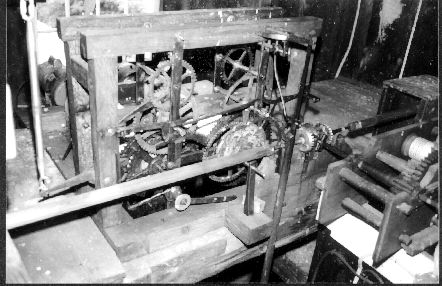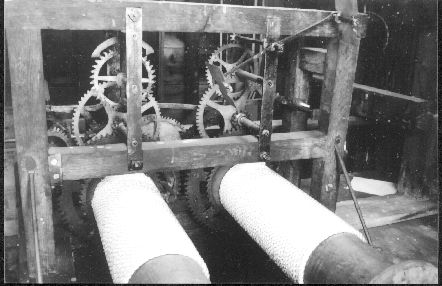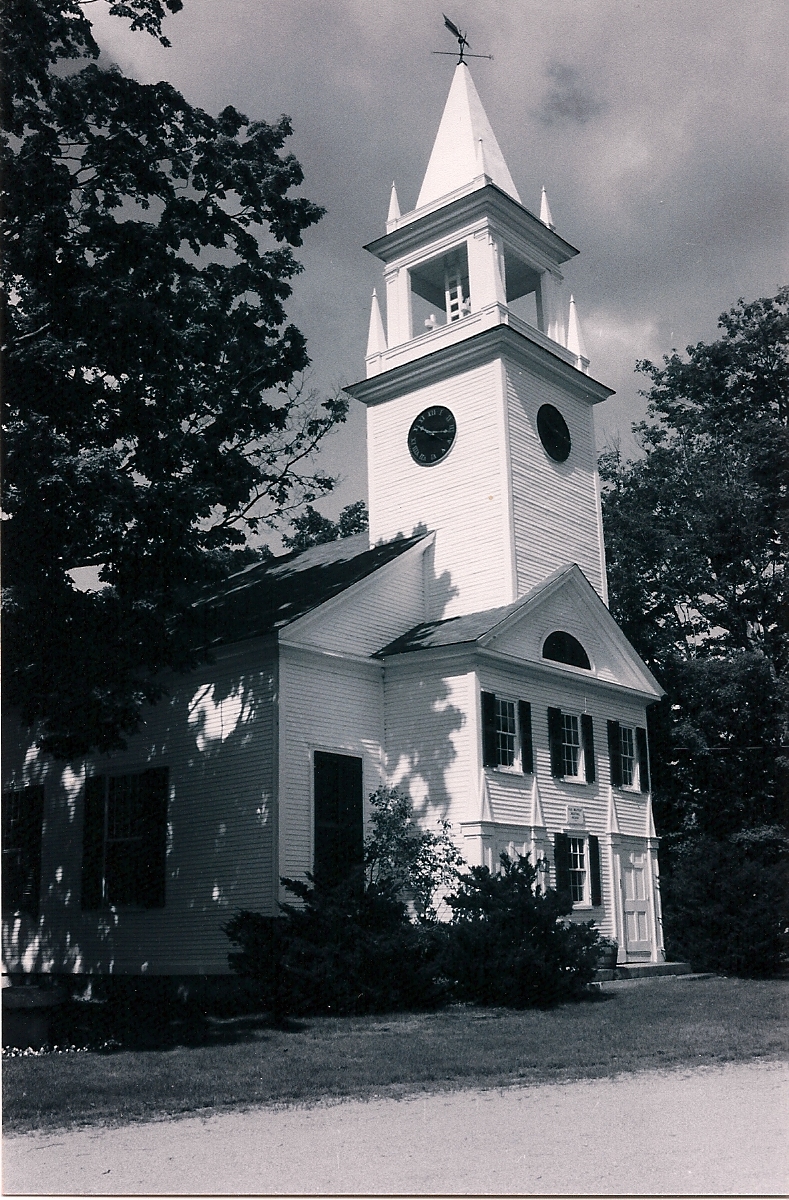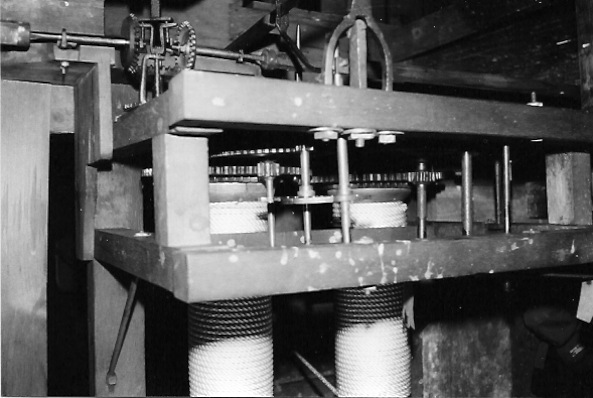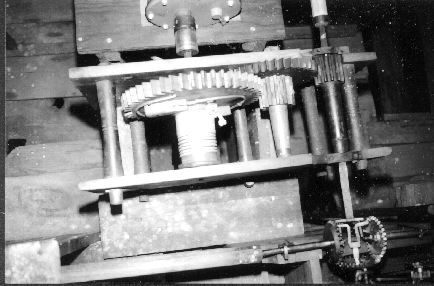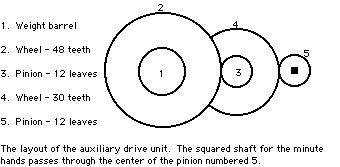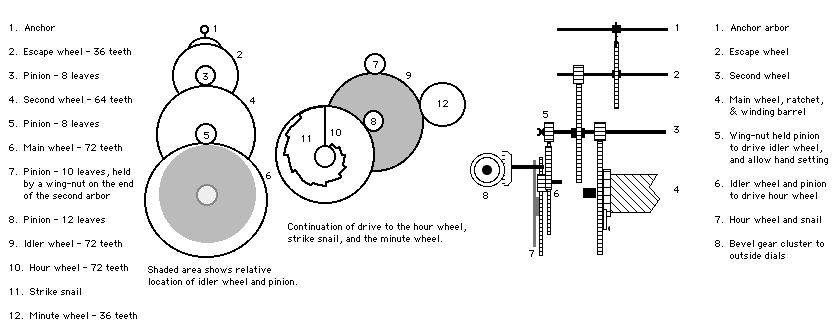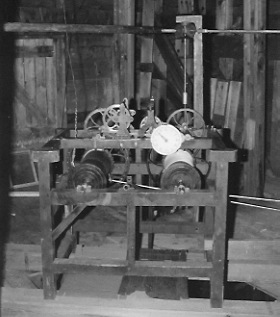Morrill's clocks
are all flatbeds, with decoratively spoked wheels and pinwheel
escapements, and don't require an auxiliary drive for the outside dial hands.
A Bit of Speculation--Who Was
The Maker?--and Similar Clocks
Unfortunately, there is little information to be found that would lead
to the identity of the maker of the clock. In 1890 the Town Historian
wrote: "After this (the 1839 remodelling of the 1794 church) Josiah
Green purchased a large clock, which he put into the steeple to remain
at his pleasure, for the use of the society and the public." The church
records suffer from poor to no record-keeping in the late 1830's---early
1840's, thus that source is of little help.
Josiah Green, born in Stoneham, Massachusetts, on 25 May, 1790, was the
eldest of nine children born to Captain Josiah Green, Jr. and Susannah
(Buckman) Green, who removed to Salisbury from Stoneham, Massachusetts,
in 1800. Josiah apprenticed at 14 to a carpenter/builder in South
Reading (now Wakefield, a suburb of Boston), Massachusetts, in 1804. He
married Clarissa Sweetser in Wakefield on 21 January, 1817, and upon
returning to Salisbury shortly afterwards, built a number of houses,
including one for himself, in which he lived for a few years. Of
particular interest is this biographical note in the Green genealogy:
"[Josiah] removed thence to the
homestead, opposite to which, in 1820, he opened a store and was in
trade until 1840, although some years previous he followed the
occupation of clock repairing6,
in which he gained a great reputation."
In this occupation he was succeeded by his son, Sylvester Walker, after
the latter's return from the 1849 gold-driven diaspora of New
Englanders.
6 It is rather curious that
the Salisbury historian only twice in some 886 pages ever refers to
making clocks---when mentioning the Blaisdell's of Salisbury and
Chester, and a Blaisdell clock owner living in Salisbury in 1890. In
another reference to clocks, in about 1830 Oliver Tucker (Salisbury
Genealogy) is said merely to have "learned the trade of clock repairer
with Mr. Durgin (Gershon Durgin, a known maker) at Andover...", rather
than being apprenticed to a clockmaker. The suspicion is that "clock
repairer" was a generic term for anyone involved with the trade.
I also found this in the History of Boscawen and Webster while
researching this clock: "Jeremiah Gerrish was a gunsmith and repairer
of clocks and watches, and made cut-nails...cutting them out of
hoop-iron with large shears driven by horsepower..."
6
The genealogical record goes on:
"Sylvester prefers a New England home,
and remains on the homestead, following his father's trade of clock
repairing, in which he enjoys a most excellent reputation throughout
central New Hampshire."
Josiah Green died at age 75, on 22 February, 1866.
Joseph Chadwick7, Morrill's contemporary and competitor
(regardless that he married Morrill's older sister) in Boscawen is not
known to have made tower clocks (he was in Lebanon, New Hampshire, by
1821) nor were there any other known tower clock makers (other than
Benjamin Morrill, whose clocks are of a different design) at work in the
area. Nathaniel Atkinson of Boscawen was 86 years old in 1839,
therefore it's unlikely that he made the clock. By way of comparison,
the two somewhat contemporaneous wood-plate/brass-wheel clocks
illustrated in Parsons' New Hampshire Clocks and Clockmakers
(Ppg. 140-143) were checked, but these clocks use count-wheel striking,
and their maker's locales and at-work dates preclude the possibility
that they were the makers.
The time train reminds one of the trains of various later---primarily
brass movement---house clocks, particularly those with an idler
(sometimes called the second wheel) between the minute arbor and the
time train. The distinctive diamond-tipped hands---a shape rarely found
on a tower clock---remind one of the hands of a much smaller house
clock. These resemblances lend some credence to the idea that a
repairer of clocks built this clock.
A thorough search of Parsons' book beyond the above-mentioned clocks
yields nothing in the way of hints concerning a possible maker's identity.
Donald K. Packard's When New Hampshire was a Clockmaking Center
is also of no help in suggesting a maker.
7 Chadwick could have made
the clock, but it is rather unlikely. His life is not thoroughly
documented, but he has been traced via census records to Lebanon, New
Hampshire, in the 1820's, and Norwich, Vermont, in the late
1830's---early 1840's.
7
There is the distinct possibility that Josiah Green himself made the
clock "...which he put into the steeple to remain at his pleasure..."
He may have purchased some of the parts and assembled them, rather than
having "purchased a large clock" from an unnamed and unidentified maker,
or he may have made the parts. The frame certainly was made by someone
intimately conversant with the wood joinery of the times, yet the
overall construction and the utilitarian---perhaps even
crude---appearance of the clock's other parts suggests that it was made
by someone who had not apprenticed to a clockmaker, but who had picked
up bits and pieces of the clockmaker's skills and designed and built a
tower clock whose train layout is very similar to those of smaller
clocks. There is an admixture of sophistication---the pendulum box;
makeshift design---the wedge-held pendulum bob; and old-fashioned design
seen in the frame style that poses an intriguing question concerning
just what sources of information the maker consulted in designing the
clock. None of Green's contemporaries (Thomas Woolson, Jr. and Luther
Elliott in Amherst, Stephen Hasham in Charlestown, and Benjamin Morrill,
the last just a few miles away in Boscawen) made anything but flatbed
tower clocks, nor are there any known chairframe clocks in either New
Hampshire or Massachusetts. The sole exception is the (possible
chairframe) clock Daniel Burnap made for South Hadley, Massachusetts, in
1802-3, which has disappeared.
A record8 of the order for this South Hadley clock is signed
"Ruggles Woodbridge, for the Committee" and dated "South Hadley, Nov.
2nd 1802." George D. Seymour9 wrote of "...the unbelievably
big models for the hands of a steeple clock." in Burnap's Andover,
Connecticut, attic work-room. Mr. Seymour also quotes the Burnap Papers
(Appendix 6); concerning the "meeting-house clock for South Hadley,"
and the "steple" clock therefor, of which Burnap wrote; "I think it is a
matter of uncertainty whether I shall be able to finish it so as to get
it to you before sleighing." (Appendix 5.) Ela Burnap's (his nephew
and one time apprentice), correspondence on tower clocks from Rochester,
New York (February 20, 1837), asks for construction details for a tower
clock, referring to "that clock we made when I was with you." Ela was
born in 1784, therefore he could not have seen the "clock we made when I
was with you" before 1798-1800, assuming he started his apprenticeship
at 14 to 16 years of age.
8 HOOPES, Penrose R.
The Shop Records of Daniel Burnap:
The Connecticut Historical Society, 1958. Pg. 31.
9 SEYMOUR, George Dudley, Daniel Burnap---Master Clockmaker:
NAWCC BULLETIN # 105, Pg. 811.
8
A chairframe clock10 attributed to Burnap is in the
collections of the Connecticut Historical Society, but the only
(extremely tenuous) link to Burnap is found in the description of a
similar clock in his Memorandum Book.
Regardless of who the maker of the Salisbury Heights tower clock was, it
is an interesting and now-documented clock, and as a side benefit, four
more names---Josiah and Sylvester Green, Oliver Tucker and Jeremiah
Gerrish---have been added to the ranks of New Hampshire horologists.
10 See Early American Tower Clocks, Ppg.25 - 27,
and Shop Records of Daniel Burnap;
"Form of the Suffield Clock."
9
BIBLIOGRAPHY
BISSELL, Charles, THE SUFFIELD TOWER CLOCKWORKS:
BULLETIN of the Connecticut Historical Society, Volume 27, Number
2.
COFFIN, Charles Carleton, Comp., THE HISTORY of BOSCAWEN and WEBSTER, N.H.
from 1733 to 1878. Printed by the Republican
Press Association, Concord, New Hampshire. 1878.
DEARBORN, John J., Coll., THE HISTORY of SALISBURY NEW HAMPSHIRE,
from date of settlement to the present time.
Printed by
William E. Moore, Manchester, New Hampshire. 1890.
HOOPES, Penrose Robinson,
CONNECTICUT CLOCKMAKERS of the EIGHTEENTH CENTURY;
Edwin Valentine Mitchell,
Hartford, Connecticut. 1930.
____, SHOP RECORDS OF DANIEL BURNAP;
The Connecticut Historical Society, Hartford, Connecticut. 1958.
PACKARD, Donald K., WHEN NEW HAMPSHIRE was a CLOCKMAKING CENTER;
Historical New Hampshire, An occasional
publication of the
New Hampshire Historical Society: April, 1950.
PARSONS, Charles S., NEW HAMPSHIRE CLOCKS and CLOCKMAKERS:
Adams-Brown Co., Exeter, New Hampshire. 1976.
SHELLEY, Frederick M., EARLY AMERICAN TOWER CLOCKS:
National Association of Watch and Clock Collectors, Columbia,
Pennsylvania. 1999
10
Return to Page Three
of the late Donn Haven Lathrop's three main pages.
Compare Donn's
original
version of this page
if it still exists.
To comment on this page, please
|
